Get The Best PageSpeed Score
For Your WordPress Website

Core Web Vitals Assessment Failed: How Can You Fix It?
To fix the core web vitals assessment: failed issue, you need to identify the core web vitals issues. According to that, this can be achieved by optimizing your LCP, INP, and CLS performances.
Optimization techniques such as Image optimization, lazy loading, browser caching, CSS, and JavaScript optimization can be used to fix the core web vitals assessment: failed issue.
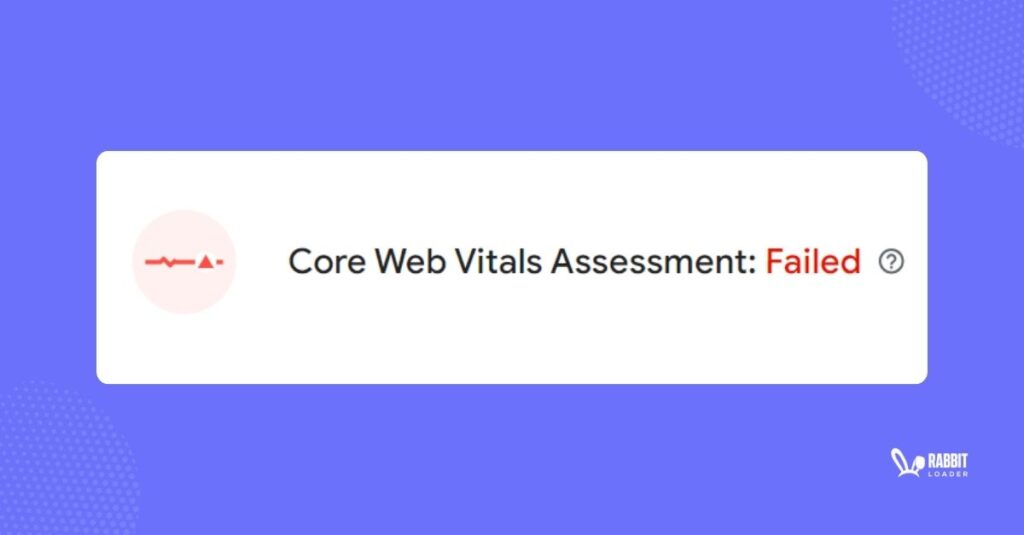
Google clarified that Core Web Vitals is one of the factor that will be used to determine Search Engine Optimization (SEO) rankings. Thus, it is crucial for website owners or developers to ensure that their websites pass this assessment.
If you are a solo-premier or running a small team and do not always have access to a developer, here we will show you how you can solve the issue for your WordPress website using RabbitLoader.
What Are Core Web Vitals?
Let’s understand the core web vitals. Google developed a set of metrics to determine a website’s performance based on the following factors:
- The initial page loading time: how long it takes it to initially load the webpage.
- The user interaction: how fast it responds to the user’s request.
- The web page’s visual stability: how stable the web page is.
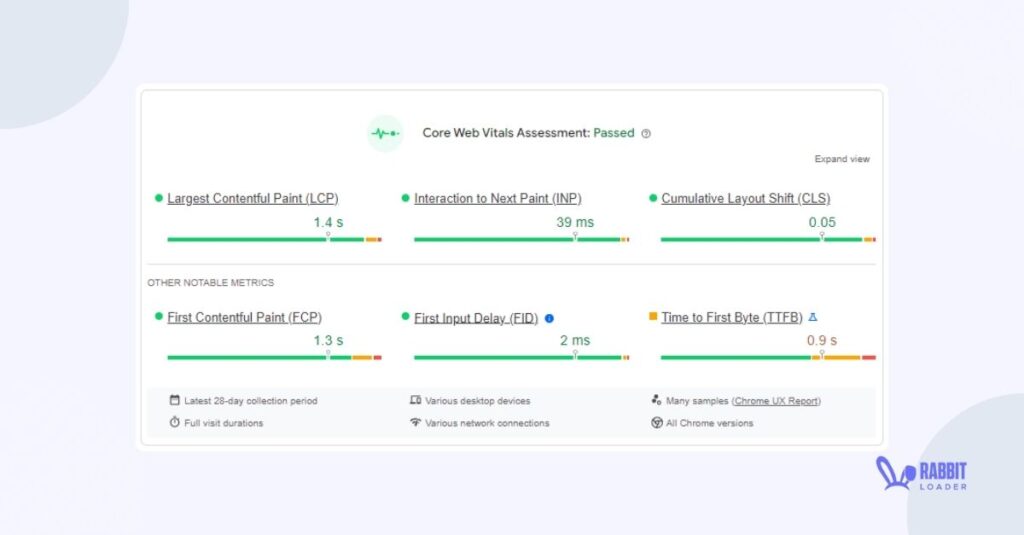
Based on the above factor, Google introduced the three main pillars of the core web vital which include: Largest Contentful Paint (LCP), First Input Delay (FID), and Cumulative Layout Shift (CLS).
Largest Contentful Paint (LCP)
The Largest Contentful Paint (LCP) determines how quickly a website loads. This user metric calculates how long it takes for the biggest element on a page, such as a hero image or a large text block, to display on the user’s browser.
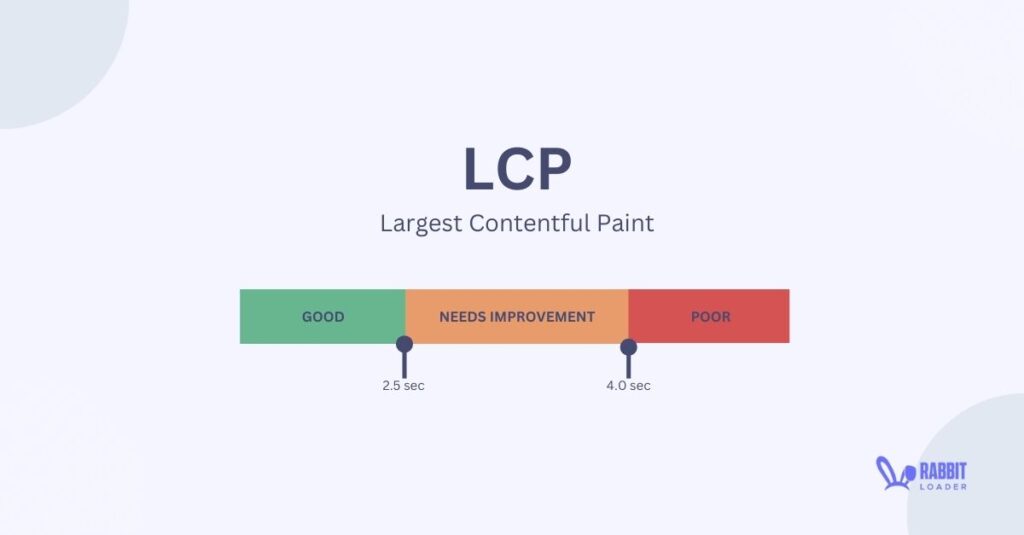
A good LCP performance can improve the website’s loading time as well as the user experience, increasing the conversion rate.
First Input Delay (FID)
First Input Delay (FID) is a metric that determines a web page’s interactivity. It is defined as the span of time between the first user interaction with a web page and the browser’s response to that user interaction.
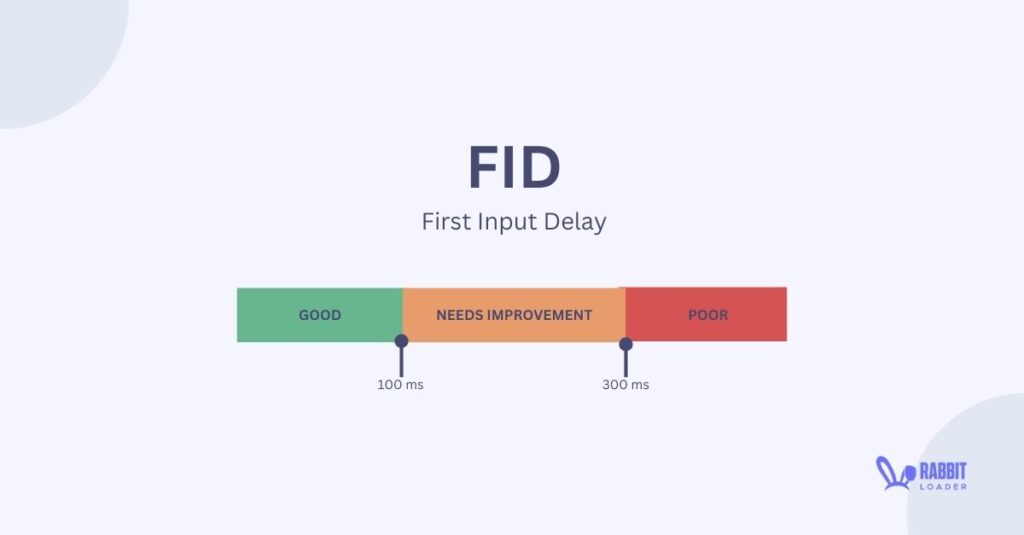
This user interaction could be tapping on a link, pressing the keyboard, or clicking a button.
Note: Google has introduced a new performance metric, Interaction to Next Paint (INP) to replace the FID.
Cumulative Layout Shift (CLS)
Cumulative Layout Shift (CLS) is a performance metric that determines a web page’s visual stability. It quantifies the amount of unexpected layout shift that occurs during the page’s loading phase.
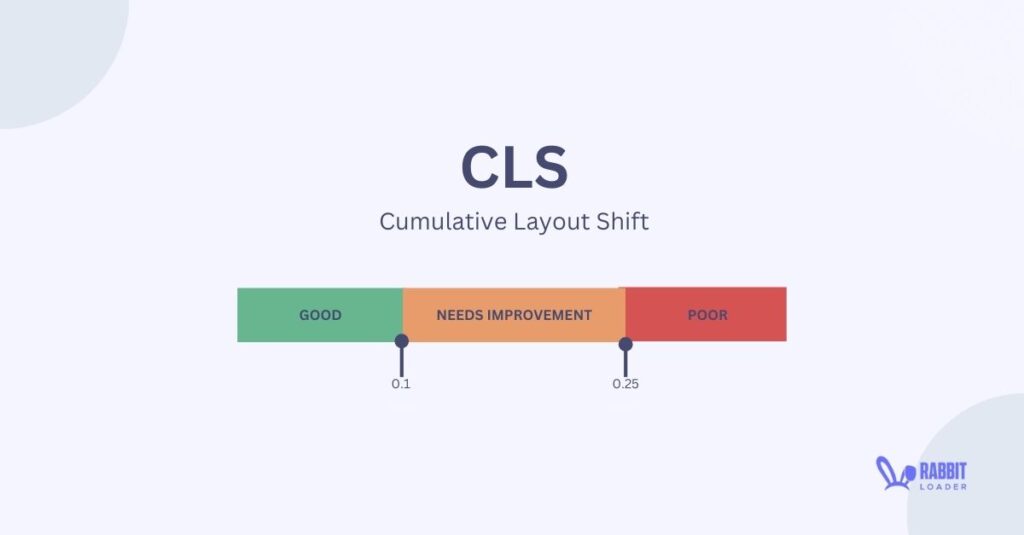
Unlike the above two performance metrics, Cumulative Layout Shifts (CLS) is not any amount of time, therefore can’t measure CLS in seconds or milliseconds.
What Is The Meaning Of Core Web Vitals Assessment: Failed?
If one or more of the three performance metrics, LCP, FID, or CLS, on your website, does not meet the threshold values, it indicates that your site does not pass the Core Web Vitals assessment in Google PageSpeed Insights.
- A failed LCP: It takes a lot of time to render the largest element on the web page.
- A failed FID: A poor performance of user interaction.
- A failed CLS: the page’s content shifts during its lifespan.
The Impact Of Core Web Vitals Assessment: Failed
According to the webFX website, 40% of online users will leave a website if it takes more than 3 seconds to render the content. hence if your website fails the core web vitals assessment, it will negatively impact the average on-page time which is an organic ranking factor
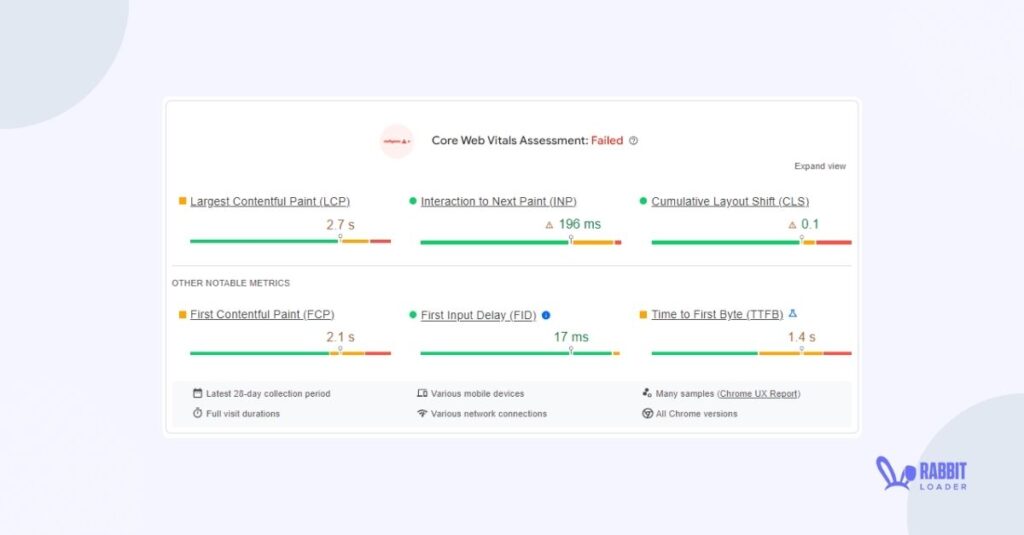
According to a survey, almost 70% of users say that an e-commerce store’s website page speed impacts their willingness to buy from it. Therefore, the poor performance of core web vitals can negatively affect your website’s conversion rate.
Not only the conversion rate but also failed core web vitals harm your Google rankings. According to a case study, redBus, the popular bus ticket platform, optimizes its core web vitals. As a result, the conversion rate has improved by 7%. Therefore, we can conclude that for many businesses, this could be a make-or-break factor.
How To Measure Core Web Vitals?
It’s essential to understand the core web vitals assessment reports and their issues to fix them. When you audit your website’s page speed performance in Google PageSpeed Insights, the first thing you can see is the core web vitals assessment.
Google PageSpeed insights provide the core web vitals assessment based on lab and field data. While the lab data is collected from the laboratory report in the Google Lighthouse in a controlled environment, field data is collected from the Chrome User Experience Report (CrUX).
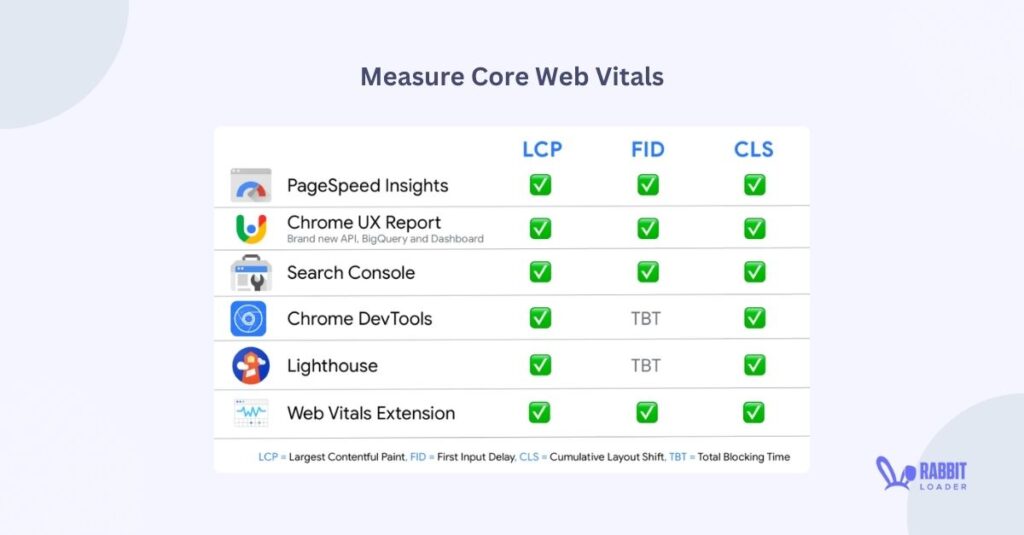
In order to determine the core web vitals assessment report, Google set some specific values for the core web vitals. For more details, you visit our core web vitals blog.
Google PageSpeed Insights also provides suggestions for improving the performance of the core web vitals and passing the core web vitals assessment.
Implementing these suggestions will help you improve your core web vitals performance and boost your conversion rate by providing a seamless experience to your users. Below are the strategies for implementing these suggestions.
FAQ: what are the helpful tools to identify the core web vitals issues and optimize them?
There are several tools available online to identify your website’s issues that are failing you the core web vitals assessment. While tools like GTmatrix allow you to test individual pages for free, you might have to invest a little bit if you need a detailed assessment for the entire website on tools like GTmatrix, and DebugBear.
Get The Best PageSpeed Score
For Your WordPress Website
To fix the issues, you can either hire a web developer or use a tool like RabbitLoader which helps you optimize your entire website for the best performance.
How To Pass The Core Web Vitals Assessment?
Here, we will discuss the most common Google PageSpeed Insights warnings and how you can easily mitigate them using RabbitLoader and passing the core web vitals assessment.
Efficiently Encode Images
The Efficiently Encode Images warning in PSI indicates that you need to optimize your images to reduce their size without harming their quality. This could be done using lossless compression, a technique that reduces an image’s size without sacrificing its original quality.
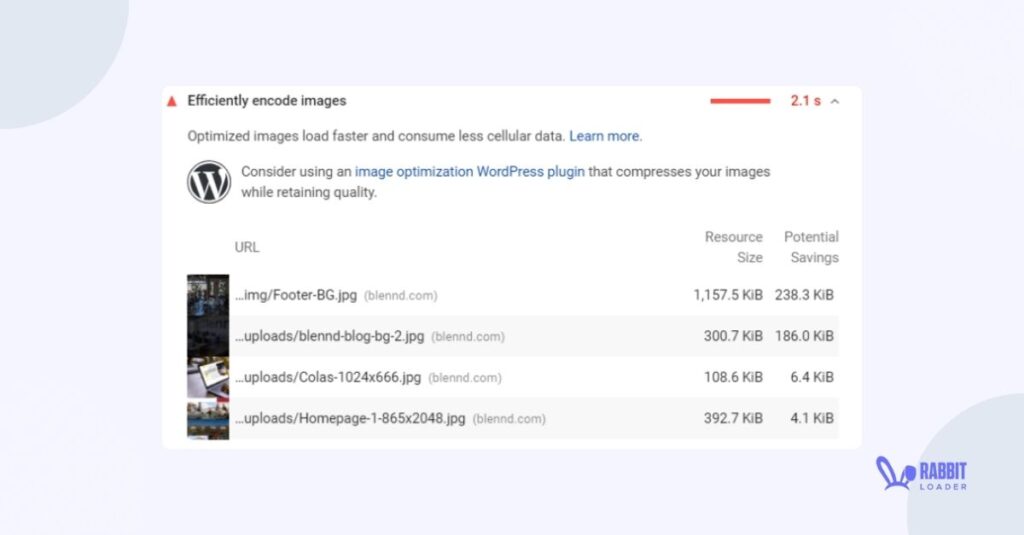
Any uncompressed image on your page would result in a larger page size for your website since the unoptimized image itself has a higher file size. Learn more with our previous blog.
Let’s see how RabbitLoader mitigates this issue.
- Losslessly Compressing The Images
Compressing large images can reduce their size. There are two types of image compression: lossless compression, which compresses images without sacrificing quality, and lossy compression, which reduces the image size along with its quality.
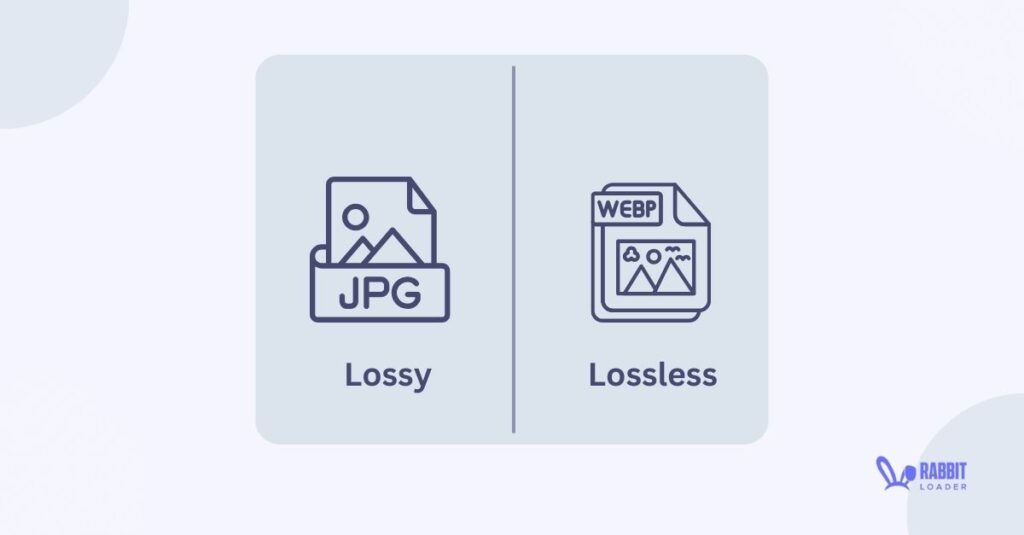
RabbitLoader’s in-built lossless compression capability reduces image size without sacrificing quality.
- Optimizing Images By Converting Them Into Next-Gen Formats
Another effective method for resolving this Efficiently Encode Images warning is image optimization. You can resolve this issue by converting your large-sized JPEG and PNG images into next-gen image formats such as AVIF and WebP.
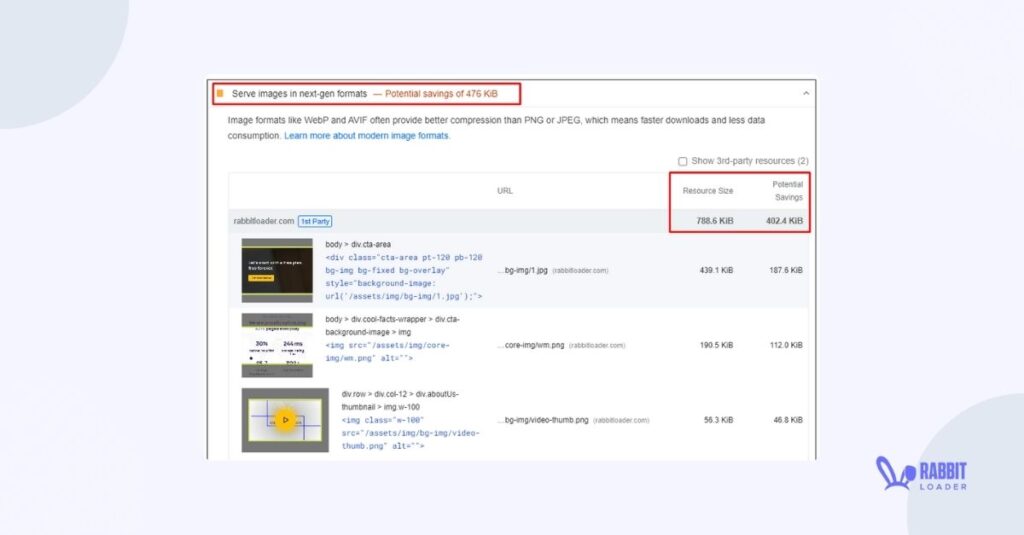
An in-built bulk image optimizer in RabbitLoader can convert your all PNG and JPEG images to WebP and AVIF formats. Converting them to these next-gent formats can save approximately 39% of your image loading times.
Reduce Initial Server Response Time
The time it takes for a server to respond to a browser request is known as the server response time. If your website takes a long time to respond to the browser request, you will come across this page speed warning “Reduce Initial Server Response Time”.
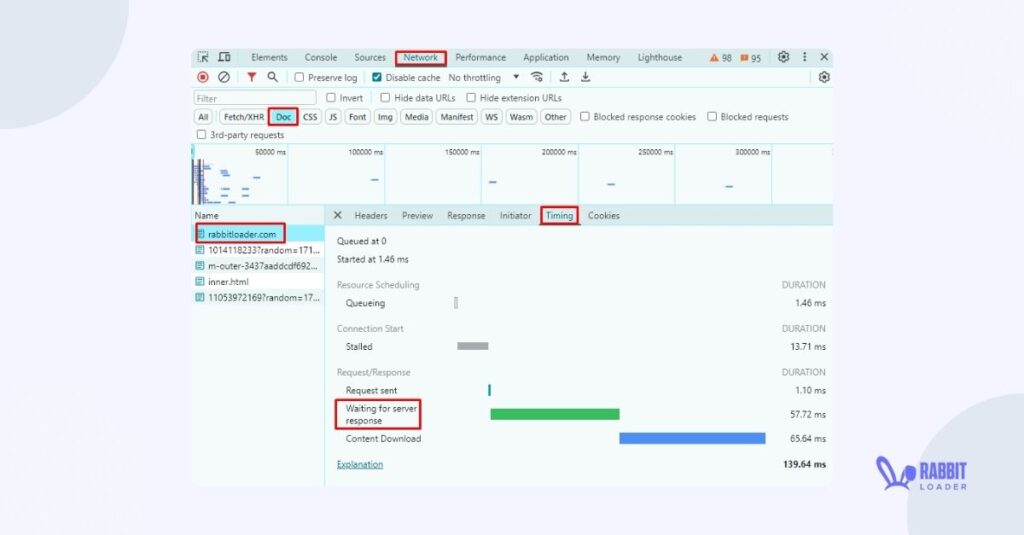
Let’s see how RabbitLoader can help you to resolve the “reduce initial server response time” warning.
- Browser Caching
Using a browser caching technique can significantly reduce the initial server response time by temporarily storing your static resources in the browser cache during the first visit. When the visitor revisits the site, the cached content is rendered from the browser cache, reducing server response time.
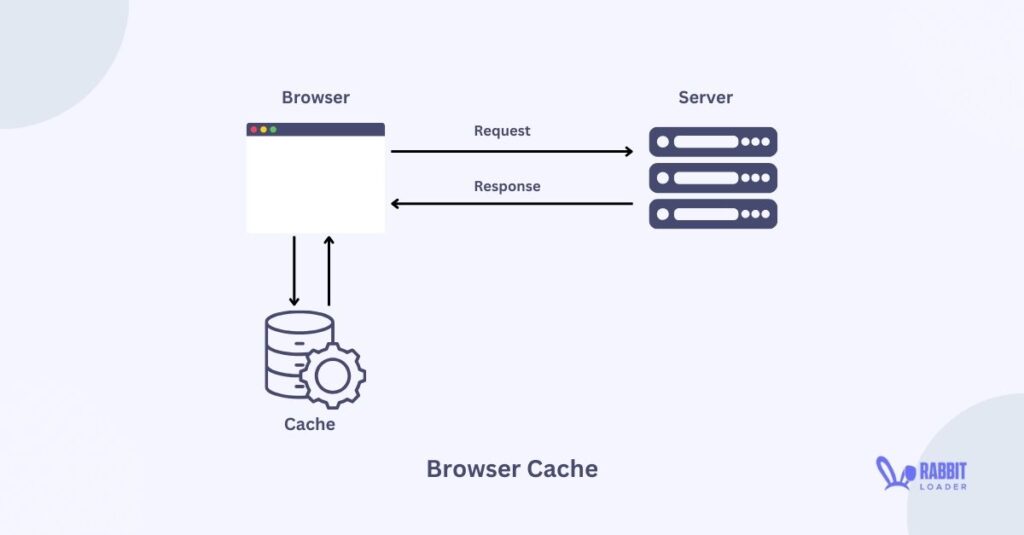
When optimizing your website by using RabbitLoader, it takes care of your browser caching and also adds the cache invalidation to keep your cached control stale-free.
- Content Delivery Network
Due to the high physical distance between the visitor and the server, network latency can occur, increasing the initial server response time. It would negatively affect your user experience.
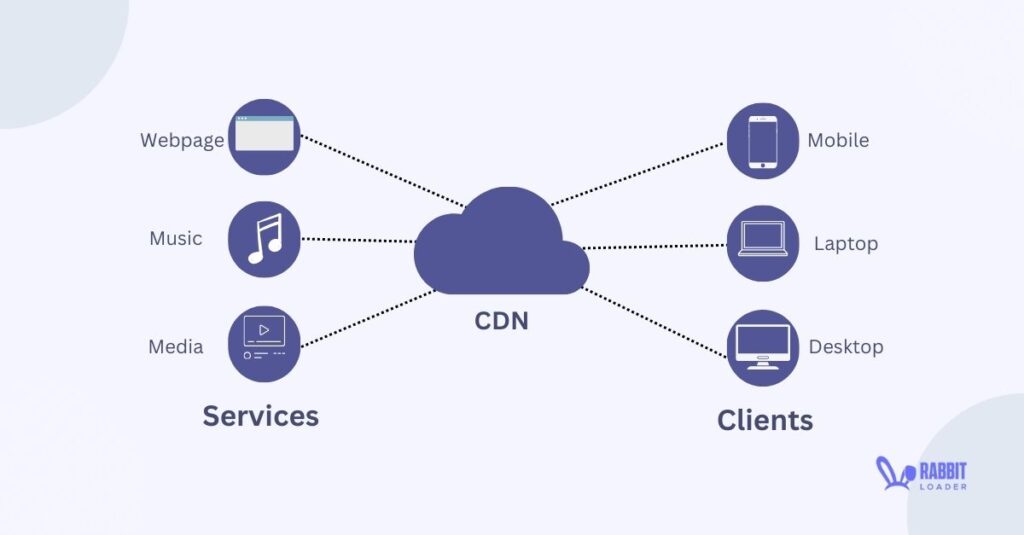
By using a premium Content Delivery Network (CDN) with 300+ edge/ proxy servers, RabbitLoader can reduce the initial server response time by minimizing the network latency.
- Load The Above-The-Fold Images First
During web page rendering, the browser generally first loads all of the page’s assets, which can increase the initial server loading time. By implementing lazy loading, you can only load the assets essential to render the above-the-fold content first.
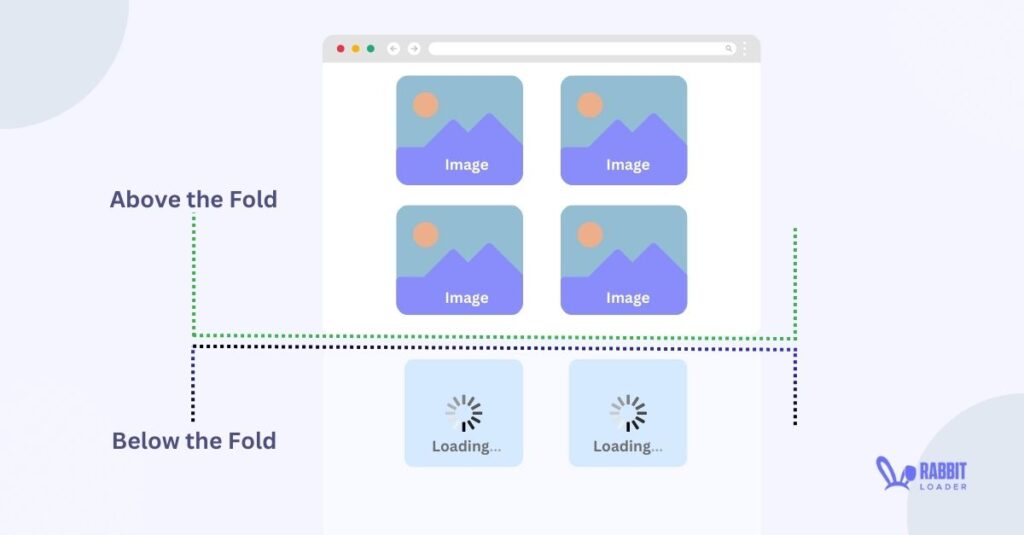
RabbitLoader defers your below-the-fold graphics by enabling the lazy load optimization technique. This reduces the server response time and enhances the performance of the core web vitals, particularly LCP, CLS, and INP.
- Generating Critical CSS Files For The Above-The-Fold Content
The CSS rules required to render the above-the-fold content, are known as critical CSS. Therefore, these styles are essential for rendering the above-the-fold content. By generating critical CSS, you can reduce the initial server response time. For more details visit our previous blog.
RabbitLoader identifies the critical resources of your webpage and generates a separate file. This can help you to improve the core web vitals performance especially LCP and INP performance.
Avoid Enormous Network Payloads
If your website’s page size exceeds the recommended size (less than 1600 KiB), Google PageSpeed Insights triggers the error “Avoid Enormous Network Payloads” for pages that do not adhere to this recommendation. Therefore, to mitigate this warning, you need to optimize the core web vitals by following the below techniques along with the above techniques:

- Minify Stylesheets, Scripts, And HTML Files
Minifying stylesheets, scripts, and HTML files can reduce the total page size by reducing the unnecessary characters from these files. These unnecessary characters can be comments, line breaks, and white press which developers often use to increase the readability.
RabbitLoader minifies these resources to mitigate this Avoid Enormous Network Payloads warning and improve your core web vitals performance.
- Compress All Resources Files
Compression is a technique for reducing the size of CSS and JavaScript files by reducing the redundancy of the code. In simple words, by compressing, you can replace the repeated strings with a single pointer, decreasing the page size.
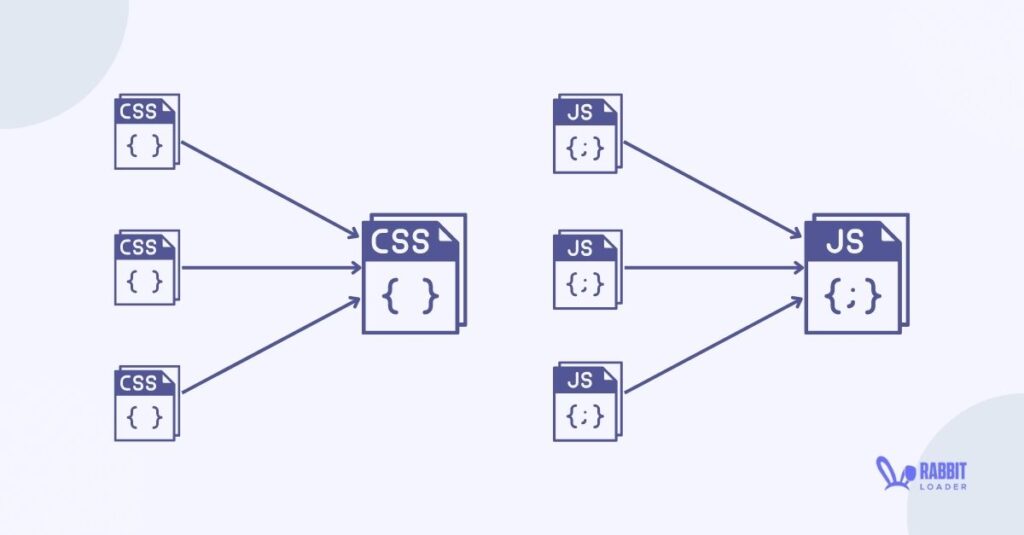
Resource compression can be of two types: GZIP and brotli. While GZIP is the traditional compression technique, brotli uses the modern compression method. RabbitLoader uses brotli compression and helps you pass the core web vitals assessment by optimizing them.
- Reduce Unused CSS
Reduced unused CSS is the most common Google PageSpeed Insights warning if you don’t use one or more than one CSS style on your website but define it in the stylesheets. This also increases the page size.
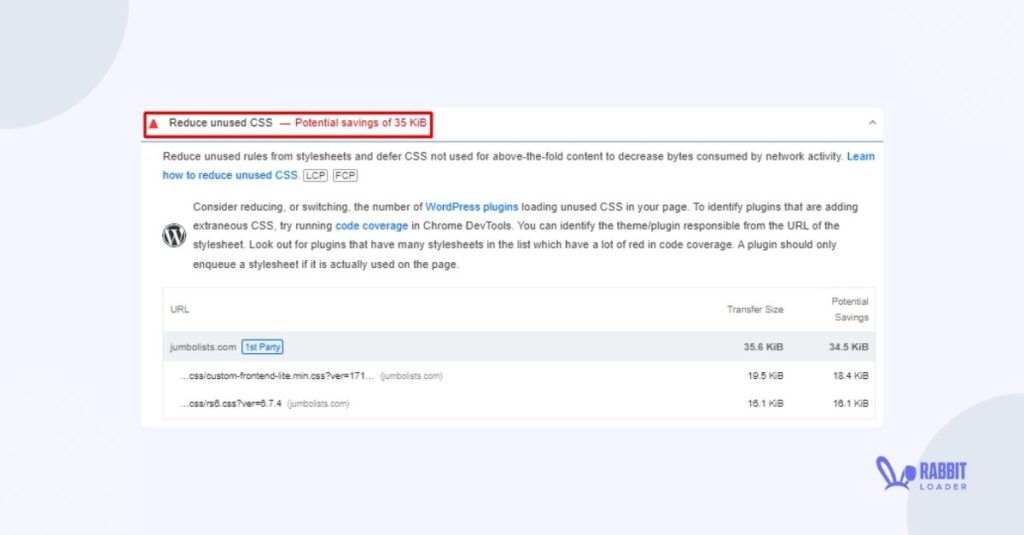
When you are using RabbitLoader for website optimization, in the optimized version, you get a new CSS file where only the required CSS rules will be present. Therefore, your page size will be significantly reduced, which will positively affect your core web vitals performance.
Image Elements Do Not Have Explicit Width And Height
Adding an image without setting the proper width and height can trigger the “image elements do not have explicit width And Height” warning. This is one of the most common reasons for your poor CLS score.
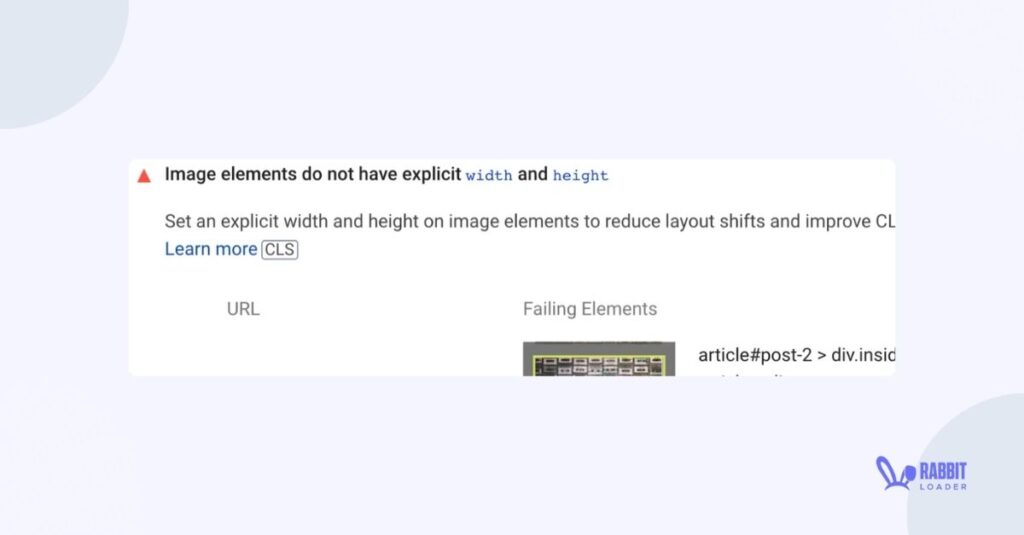
RabbitLoader automatically resizes your images to fit every screen size, preventing shifting and enhancing both the user experience and CLS performance. Therefore, you can easily pass the core web vitals assessment.
Avoids An Excessive Dom Size
The browser creates a DOM tree during web page loading. A large DOM size often increases memory usage, and so does the webpage loading time, affecting your core web vitals assessment. To solve this warning, you can follow the techniques:

- Avoid Using Third Party Script
When you use a third-party script, like Google ads, the DOM size can be increased, slowing your website’s page speed. So, in order to pass core web vitals, you need to avoid using third party scripts.
- Don’t Use Too Many Optimization Plugins
Plugins can optimize your website’s page speed performance, but sometimes, using too many plugins can decrease your website’s performance. They also have stylesheets and scripts. During a page, these files need to be executed, slowing your website by increasing the DOM size.
RabbitLoader is an all-in-one optimization tool with 10+ optimization features that prevent the use of too many optimization plugins, mitigating this “avoid an excessive DOM size”. Therefore you don’t need to invest your money in using different optimization plugins.
Get The Best PageSpeed Score
For Your WordPress Website
RabbitLoader is able to reduce the DOM size by compressing your HTML file. Also when you are using RabbitLoader, you don’t need to use too many plugins. As you can see, RabbitLoader can optimize almost all resources, thus, you don’t need to use too many plugins.
Minimizes Main-Thread Work
Google PageSpeed Insights triggered the “Minimize main-thread work” warning if the main thread is blocked by the other tasks. This is one reason your core web vitals assessment might fail,
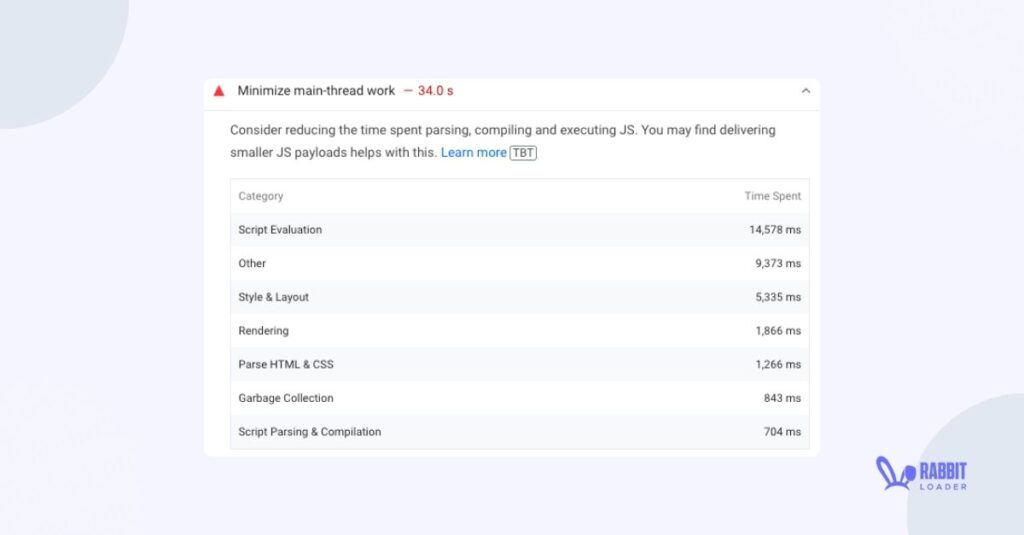
Minimizing the main thread work can speed up your website and improve the performance of Interaction to Next Paint (INP). The best practice is to optimize your JavaScript files to minimize the main thread work.
- JavaScript Optimization
JavaScript file is used to make an interactive web page and increase the average on-page time. However, JavaScript blocks the main thread and increases the INP time.
Some JavaScript functions are needed during the initial loading time like any warning or alerting pop-up. Apart from these functions, RabbitLoader defers the rest of the non-priority JavaScript functions, improving the initial loading time.
In addition, RabbitLoader supports multithreading, so we can use other threads simultaneously if the main thread becomes busy.
Eliminate Render-Blocking Resources
An unoptimized image, unused CSS, and JavaScript files block the main thread and act as render-blocking resources. Because of them, you can see the warnings “eliminate render-blocking resources”.
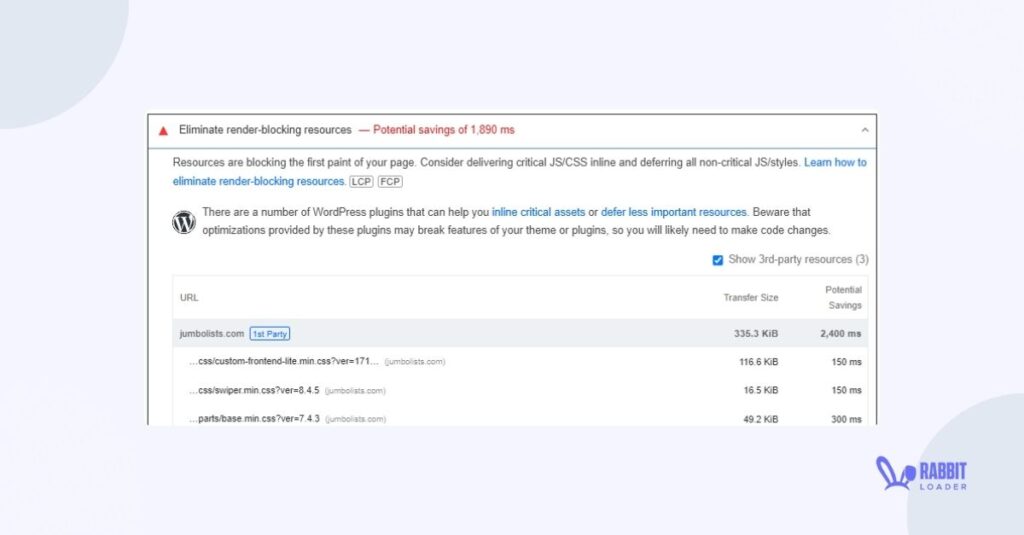
Therefore by optimizing the image, CSS, and JavaScript file, you can easily eliminate the render-blocking resources and pass the core web vitals assessment. We have already discussed the optimization techniques.
A quick recap of the core features of RabbitLoader:
Losslessly compressing the images
Optimizing the images by converting them into WebP and AVIF format
Using a browser caching mechanism
Using a premium Content Delivery Network (CDN)
Loading the above-the-fold images fast
Generating critical CSS
Minifying stylesheets, scripts, and HTML files
Compressing all resource files
Reducing the unused CSS
Optimizing the JavaScript files
Allowing multi-threading
Conclusion
Is your Core Web Vitals assessment: Failed in Google PageSpeed insights? As discussed, it directly affects your user experience, conversion rate, and Google rankings. By optimizing your core web vitals you can easily pass the core web vitals assessment.
Here we have mentioned a non-coding solution, RabbitLoader which can help you pass the core web vitals assessment and increase the overall score in Google PageSpeed Insights.
Get The Best PageSpeed Score
For Your WordPress Website